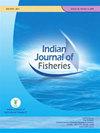对印度西南海岸 Auxis rochei(Risso,1810 年)渔业、生物学和种群动态的深入了解
IF 0.3
4区 农林科学
Q4 FISHERIES
引用次数: 0
摘要
Auxis rochei是对印度金枪鱼上岸量贡献巨大的沿海金枪鱼之一,平均(2014-2019年)年捕获量为7210吨,喀拉拉邦位居第一,年平均上岸量为3176吨。渔业包括14.5-39.6厘米叉长(FL)大小组,平均长度为27.64厘米,主要模式为26厘米FL。集合鱼类的长度-重量(L-W)关系表示为 W= 0.000003 L3.22 (r2= 0.91)。鱼类 1.5 岁时的初生体型估计为 25.8 厘米 FL。每次产卵的卵数从 84562 粒到 133698 粒不等,卵子直径从 0.1 毫米到 0.6 毫米不等,表明卵母细胞发育不同步,存在多次产卵现象。4 月、5 月和 6 月记录到较高的胃肠道指数(GSI),与最低的胃肠道指数(GaSI)相吻合。招募模式呈双峰型,招募强度从 0.79% 到 17.89% 不等。生长呈异速生长,得出的 von Bertalanffy 生长方程为 Lt=43.5(1-e-0.8(t+0.0212))。生长性能指数(ɸ)为 3.18,鱼的寿命估计为 3.7 年。一龄以上的鱼类维持着渔场(22 - 32 cm FL)。估计总死亡率(Z)、自然死亡率(M)和捕捞死亡率(F)分别为 3.70、1.40 和 2.30,开发率(E)为 0.62,开发率(U)为 0.60。Beverton 和 Holt 的每新梢产量(Y/R)和每新梢生物量分析表明,Emax 为 0.87,远高于目前的开发水平,反映了沿海的可持续渔业。汤普森和贝尔分析表明,在 F 系数为 2.6 时,MSY 为 8125 吨。生物参考点FCURR/FMSY(0.4)和BCURR/BMSY(1.5)均处于安全水平,表明渔业有增殖的空间。关键词:生物参考点 繁殖率 生长率 GSI 长宽关系 平均长度 死亡率 SSB本文章由计算机程序翻译,如有差异,请以英文原文为准。
An insight into the fishery, biology and population dynamics of Auxis rochei (Risso, 1810) along the south-west coast of India
Auxis rochei is one of the coastal tunnies contributing substantially to the tuna landings inIndia, with an average (2014-2019) annual catch of 7210 t. Kerala stood first, with an annualaverage landing of 3176 t. The fishery comprised 14.5 - 39.6 cm fork length (FL) size groupswith a mean length of 27.64 cm and a major mode of 26 cm FL. The Length-weight (L-W)relationship of pooled fishes was expressed as W= 0.000003 L3.22 (r2= 0.91). The size at firstmaturity was estimated at 25.8 cm FL when the fish was 1.5 years old. The number of eggsper spawning ranged from 84,562 to 1,33,698 and the ova diameter ranged between 0.1and 0.6 mm, indicating asynchronous oocyte development with multiple spawning. Highergonadosomatic index (GSI) was recorded during April, May and June and coincided withthe minimum gastrosomatic index (GaSI). The recruitment pattern was bimodal, with variedintensity ranging from 0.79-17.89%. Growth was allometric and the von Bertalanffy growthequation derived was Lt=43.5(1-e-0.8(t+0.0212)). The growth performance index (ɸ) was 3.18 andthe longevity of the fish was estimated at 3.7 years. One-year-old plus fishes sustained thefishery (22 - 32 cm FL). Total mortality (Z), natural mortality (M) and fishing mortality (F)were estimated at 3.70, 1.40 and 2.30, respectively, with an exploitation rate (E) of 0.62and the exploitation ratio (U) of 0.60. Beverton and Holt yield per recruit (Y/R) and Biomassper recruit analysis indicated that the Emax was at 0.87, much higher than the present levelof exploitation, reflecting the sustainable fishery along the coast. Standing stock biomass(SSB) was estimated at 7215.7 t, and the spawning stock biomass formed 55.5% of the SSB.Thompson and Bell analysis indicated the MSY as 8125 t, at F-factor, 2.6. The biologicalreference points FCURR/FMSY (0.4) and BCURR/BMSY (1.5) were at safe levels, signifying the scopefor fishery enhancement. Keywords:Biological reference point, Fecundity, Growth, GSI,L-W relationship, Mean length, Mortality, SSB
求助全文
通过发布文献求助,成功后即可免费获取论文全文。
去求助
来源期刊

Indian Journal of Fisheries
FISHERIES-
CiteScore
0.90
自引率
20.00%
发文量
0
审稿时长
6-12 weeks
期刊介绍:
Indian Journal of Fisheries is published quarterly by the Indian Council of Agricultural Research (ICAR), New Delhi. Original contributions in the field of Fish and fisheries science are considered for publication in the Journal. The material submitted must be unpublished and not under consideration for publication elsewhere.
Papers based on research which kills or damages any species, regarded as thratened/ endangered by IUCN crieteria or is as such listed in the Red Data Book appropriate to the geographic area concerned, will not be accepted by the Journal, unless the work has clear conservation objectives.
 求助内容:
求助内容: 应助结果提醒方式:
应助结果提醒方式:


